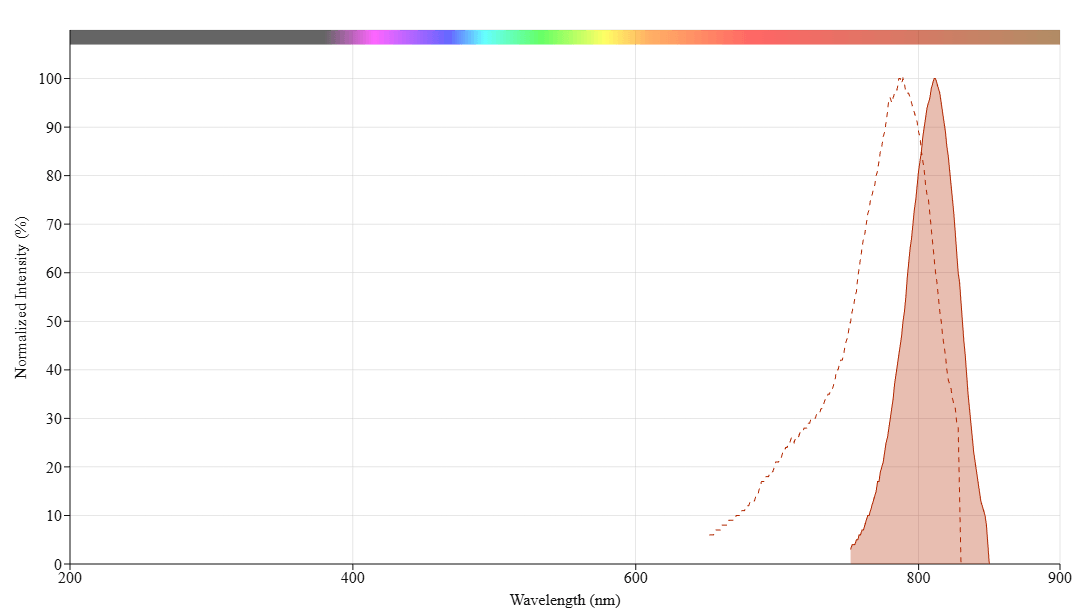iFluor® 790 amine
In vivo fluorescence imaging uses a sensitive camera to detect the fluorescence emission from fluorophores in whole-body living small animals. To overcome the photon attenuation in living tissue, fluorophores with long emission at the near-infrared (NIR) region are generally preferred, including widely used small indocarbocyanine dyes. Recent advances in imaging strategies and reporter techniques for in vivo fluorescence imaging include novel approaches to improve the specificity and affinity of the probes and to modulate and amplify the signal at target sites for enhanced sensitivity. Further emerging developments aim to achieve high-resolution, multimodality, and lifetime-based in vivo fluorescence imaging. Our iFluor® 790 is designed to label proteins and other biomolecules with near-infrared fluorescence. Conjugates prepared with iFluor® 790 have excitation and emission spectra similar to that of indocyanine green (ICG) and the IRDye® 800, with 787/812 nm excitation/emission maxima. iFluor® 790 dye emission is well separated from commonly used far-red fluorophores such as Cy5, Cy7, or allophycocyanin (APC), facilitating multicolor analysis. This fluorophore is also useful for small animal in-vivo imaging applications or other imaging applications requiring NIR detections, such as the two-color western applications with the LI-COR® Odyssey® infrared imaging system.
Calculators
Common stock solution preparation
Table 1. Volume of DMSO needed to reconstitute specific mass of iFluor® 790 amine to given concentration. Note that volume is only for preparing stock solution. Refer to sample experimental protocol for appropriate experimental/physiological buffers.
| 0.1 mg | 0.5 mg | 1 mg | 5 mg | 10 mg | |
| 1 mM | 82.425 µL | 412.126 µL | 824.253 µL | 4.121 mL | 8.243 mL |
| 5 mM | 16.485 µL | 82.425 µL | 164.851 µL | 824.253 µL | 1.649 mL |
| 10 mM | 8.243 µL | 41.213 µL | 82.425 µL | 412.126 µL | 824.253 µL |
Molarity calculator
Enter any two values (mass, volume, concentration) to calculate the third.
| Mass (Calculate) | Molecular weight | Volume (Calculate) | Concentration (Calculate) | Moles | ||||
| / | = | x | = |
Spectrum
Product family
| Name | Excitation (nm) | Emission (nm) | Extinction coefficient (cm -1 M -1) | Quantum yield | Correction Factor (260 nm) | Correction Factor (280 nm) |
| iFluor® 350 amine | 345 | 450 | 200001 | 0.951 | 0.83 | 0.23 |
| iFluor® 405 amine | 403 | 427 | 370001 | 0.911 | 0.48 | 0.77 |
| iFluor® 488 amine | 491 | 516 | 750001 | 0.91 | 0.21 | 0.11 |
| iFluor® 555 amine | 557 | 570 | 1000001 | 0.641 | 0.23 | 0.14 |
| iFluor® 647 amine | 656 | 670 | 2500001 | 0.251 | 0.03 | 0.03 |
| iFluor® 660 amine | 663 | 678 | 2500001 | 0.261 | 0.07 | 0.08 |
| iFluor® 680 amine | 684 | 701 | 2200001 | 0.231 | 0.097 | 0.094 |
| iFluor® 700 amine | 690 | 713 | 2200001 | 0.231 | 0.09 | 0.04 |
| iFluor® 710 amine | 716 | 739 | 1500001 | 0.601 | 0.12 | 0.07 |
Show More (2) | ||||||
Citations
View all 1 citations: Citation Explorer
Nanovesicle delivery to the liver via retinol binding protein and platelet-derived growth factor receptors: how targeting ligands affect biodistribution
Authors: Hsu, Ching-Yun and Chen, Chun-Han and Aljuffali, Ibrahim A and Dai, You-Shan and Fang, Jia-You
Journal: Nanomedicine (2017)
Authors: Hsu, Ching-Yun and Chen, Chun-Han and Aljuffali, Ibrahim A and Dai, You-Shan and Fang, Jia-You
Journal: Nanomedicine (2017)
References
View all 18 references: Citation Explorer
A target cell-specific activatable fluorescence probe for in vivo molecular imaging of cancer based on a self-quenched avidin-rhodamine conjugate
Authors: Hama Y, Urano Y, Koyama Y, Kamiya M, Bernardo M, Paik RS, Shin IS, Paik CH, Choyke PL, Kobayashi H.
Journal: Cancer Res (2007): 2791
Authors: Hama Y, Urano Y, Koyama Y, Kamiya M, Bernardo M, Paik RS, Shin IS, Paik CH, Choyke PL, Kobayashi H.
Journal: Cancer Res (2007): 2791
Fluorescence imaging in vivo: recent advances
Authors: Rao J, Dragulescu-Andrasi A, Yao H.
Journal: Curr Opin Biotechnol (2007): 17
Authors: Rao J, Dragulescu-Andrasi A, Yao H.
Journal: Curr Opin Biotechnol (2007): 17
Ex vivo fluorescence imaging of normal and malignant urothelial cells to enhance early diagnosis
Authors: Steenkeste K, Lecart S, Deniset A, Pernot P, Eschwege P, Ferlicot S, Leveque-Fort S, Bri and et R, Fontaine-Aupart MP.
Journal: Photochem Photobiol (2007): 1157
Authors: Steenkeste K, Lecart S, Deniset A, Pernot P, Eschwege P, Ferlicot S, Leveque-Fort S, Bri and et R, Fontaine-Aupart MP.
Journal: Photochem Photobiol (2007): 1157
In vivo monitoring the fate of Cy5.5-Tat labeled T lymphocytes by quantitative near-infrared fluorescence imaging during acute brain inflammation in a rat model of experimental autoimmune encephalomyelitis
Authors: Berger C, Gremlich HU, Schmidt P, Cannet C, Kneuer R, Hiest and P, Rausch M, Rudin M.
Journal: J Immunol Methods (2007): 65
Authors: Berger C, Gremlich HU, Schmidt P, Cannet C, Kneuer R, Hiest and P, Rausch M, Rudin M.
Journal: J Immunol Methods (2007): 65
A protocol for imaging alternative splicing regulation in vivo using fluorescence reporters in transgenic mice
Authors: Bonano VI, Oltean S, Garcia-Blanco MA.
Journal: Nat Protoc (2007): 2166
Authors: Bonano VI, Oltean S, Garcia-Blanco MA.
Journal: Nat Protoc (2007): 2166
Page updated on April 15, 2025



